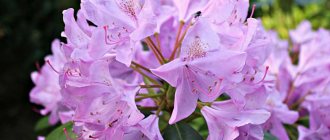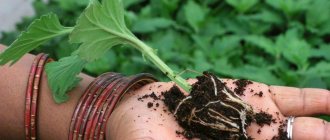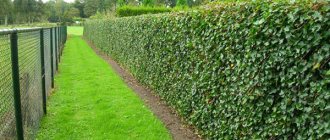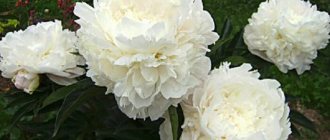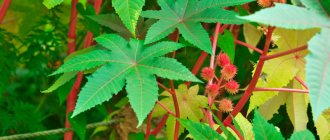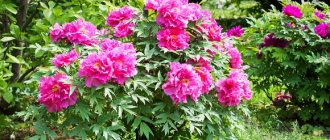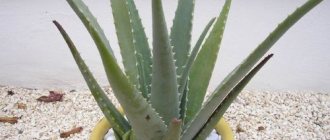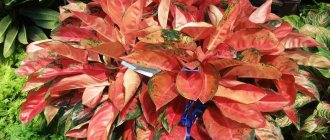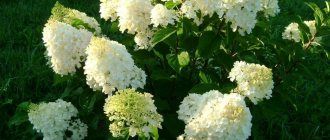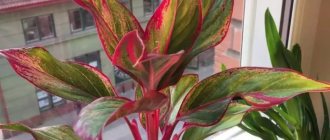Fern is a very beautiful plant with carved leaves. There are several types of them, and each type is original in its own way. A fern can transform the landscape of a garden plot beyond recognition. It can be planted near a pond, in rock gardens or in the backyard among stones and tall trees. The main requirement is partial shade and moist soil. It is not at all necessary to add a large amount of organic matter or minerals to the soil before planting a fern and when caring for it in the future. The plant will thrive in depleted soil.
Growing ferns as decoration for a garden or plot is becoming increasingly popular in transforming the landscape of a summer cottage. This ancient plant looks very decorative against the backdrop of familiar landscapes. However, fern in the garden is not only a decoration: it is also grown as a delicacy. In addition, the rhizomes of some varieties are used in medicine, and the leaves have anti-rot properties, for which they are often used to pack fruits for the winter. If your dacha garden looks relatively boring, thickets of ferns will add a unique tropical charm to it.
Ferns can be classified as the most ancient plants, which are perfectly preserved and, perhaps, will delight people for a long time. But no one could observe the flowering during all this time - in any case, no official confirmation was given. This, however, does not prevent it from occupying places in gardens and plots, complementing the landscape and being an excellent decorative element. But there are more than 10 thousand of them! It is not surprising that every summer resident could choose absolutely any specimen for himself.
Popular varieties
To achieve success when cultivating ferns in the garden, you need to choose the right type of plant.
Female Kochedyzhnik
This crop is characterized by dissected leaves that form bunches. Under natural conditions, it grows in swamps, forming hummocks. The size is determined by the crop variety and can reach 30-70 centimeters. The roots of the bush are short and thick.
Common bracken
This plant reaches 70 centimeters in height. It grows well in dry soil, which contains a small amount of useful substances. The culture is characterized by long horizontal leaves resembling eagle wings. The plant contains toxic substances, which is why it poses a danger to pets. Moreover, this type of fern is absolutely harmless for people.
Male shieldweed
Under natural conditions, the culture develops in the shade and reaches 0.3-1.5 meters. Pores resembling a shield accumulate on the underside of the leaves.
Common ostrich
This crop is distinguished by feathery leaves that resemble the openwork pattern of ostrich feathers. They can reach 1.5 meters in size. With the arrival of spring, the leaves become like a rolled cocoon. Then they bloom and resemble a luxurious cone. The vertical root system requires systematic loosening and mulching.
Asplenium
The culture is popularly called Kostenets. Most aspleniums need warmth. However, there are also frost-resistant crops that can withstand temperatures down to -18 degrees.
See also
Growing and caring for Schisandra chinensis, planting secrets
Nest-like asplenium
This plant is able to grow even without soil, since under natural conditions it takes root on leaves and trunks. The size of the culture reaches 1 meter. Its dwarf species are found in flower shops.
Bulbous asplenium
This is a deciduous fern native to New Zealand. It can be grown in the garden. In this case, it is recommended to cover the root system with dry leaves. You can also dig up the bush and keep it in the cellar until spring arrives. The length of the plant reaches 60 centimeters.
Signs on the state of the plant
There are many signs and superstitions associated with the plant. If a fern growing in a house or apartment began to wither, this means that one of the ill-wishers tried to bring damage or the evil eye to those living in the room, and the plant simply absorbed all the negativity, averting trouble.
An exotic flower is a protective barrier against people with bad intentions entering the house. It will protect the home from evil spirits, evil spirits and other dark entities.
Gamblers must have a fern in their home, as the plant will always promote good luck, bringing huge winnings to its owners. Those who want to improve their financial condition also need to have a magical plant in their home. It will bring wealth and prosperity to the house.
How to choose and prepare a place
To achieve success in growing a crop, it is recommended to choose the right site for planting it.
Lighting
The culture develops normally in shady places. At the same time, a long absence of light negatively affects the condition of the leaves. They become yellow and dull. This does not harm the crop, but provokes a deterioration in its decorative properties.
The best option for ferns is diffused sunlight. It is advisable to avoid direct sunlight.
Soil requirements
Ferns require loose soil that absorbs moisture well. To avoid stagnation of moisture and the development of putrefactive processes in the roots, you will need river sand. The excavated soil should be mixed with peat and sand. It is recommended to maintain a ratio of 2:2:1.
Building [edit | edit code ]
Ferns include both herbaceous and woody life forms.
The body of the fern consists of leaf blades, a petiole, a modified shoot and roots (vegetative and adventitious). The leaf-like organs of a fern are called fronds.
In temperate forests, ferns usually have a short stem, which is a rhizome found in the soil. The stem has well-developed conducting tissue, between the bundles of which the cells of the main parenchymal tissue are located.
Fronds unfold above the soil surface, growing from the buds of the rhizome. These organs have apical growth and can reach large sizes; They typically serve two functions—photosynthesis and sporulation. Sporangia are located on the lower surface of the frond, and haploid spores develop in them.
Reproduction methods
There are many methods of fern propagation, each of which has certain characteristics.
Disputes and division
Reproduction by spores is considered a rather complex and painstaking method. To do this, you need to cut off the ripe spores with leaves in the fall, and place them in a special substrate in January. To prepare it, you should mix peat, leaf soil and sand in a ratio of 2:1:1.
It is recommended to place the spores on top and moisten them with a spray bottle. Cover the container with glass. You can expect sprouts to appear 2 months after planting.
When propagating varieties with long rhizomes, it is enough to cut the adult plant into 2 parts in early spring. If there is no risk of return frosts, the crop should be planted in the ground. In this way you can propagate bracken, ostrich and other plants.
Rhizomatous tendrils
This method is not used for all varieties of fern. Thus, the cordifolia neurolepis has mustaches, which are presented in the form of aerial processes. They can be buried in the ground and watered well. Thanks to this, it will be possible to obtain a new culture.
Brood buds
This method is considered the most labor-intensive and least productive. For planting, it is worth separating the top of the leaves and placing them in peat or moss. They should definitely be moisturized every day. When the buds take root, they can be transplanted to a permanent location.
Ready-made bushes
This is the simplest and most popular method. To do this, just find a suitable bush in the forest and dig it up. It is important to wrap the roots with soil so that they do not dry out during transportation. It is recommended to moisten the plant a little. At home, it should be divided and planted in a permanent plot.
See also
Rules for planting and caring for indoor hibiscus at home
Description of agriculture
Ferns are the oldest plants on the planet that have survived to this day.
They are more than 400 million years old. Agriculture has more than 10,000 varieties. Moreover, they may be so different that visually they may not be combined into one culture. The culture is unpretentious to soil and resistant to high humidity. In fact, the shield plant does not have leaves. Those green leafy legs, which in our time are considered to be the leaves of a fern, are its branches. Breeders are trying to develop a variety of fern that will have full leaves. A similar variety was bred and called “Lesna”. Still, it is not considered a variety that has a full-fledged leaf. There are varieties in which the developmental form is herbaceous, and there are plants with a woody developmental form. All of them belong to the fern-like species.
Fern has medicinal properties and has long been widely used in medicine. Long-term use of fern infusions and extracts has shown that the plant can relieve many diseases of the gastrointestinal tract, liver, respiratory tract, etc. On the Internet you can find many explanations about how to make your own infusion or decoction from fern leaves.
Fern
Nowadays, ferns in the country are not uncommon. Planting and caring for ferns in open ground is not difficult. An ornamental fern or a street fern will develop equally well if given proper care. The plant can be planted even in the Urals, taking into account the climatic conditions of this region. How to plant ferns, how to grow them correctly, and how to protect ferns from diseases will be discussed below.
Open ground planting scheme
Before planting, it is worth assessing the size of the plant. Taking this into account, prepare the hole. For large varieties, its diameter should be 50 centimeters and its depth should be at least 40. It is recommended to fill the hole with the same soil in which the bush grew before replanting. Thanks to this, he adapts much more easily.
If the finished plant was purchased from a nursery, you should add peat when planting it in the hole. However, it is not recommended to use too much fertilizer. After planting is completed, the soil is mulched with mowed grass or sawdust. This helps avoid moisture loss.
Features of care
In order for the plant to develop normally, it needs to be provided with complete and high-quality care.
Watering mode
When growing ferns in the garden, you should ensure timely soil moisture. Watering should be regular. It is carried out every 5-7 days. With the arrival of autumn, the frequency of watering is reduced, since at this time the plant does not require a large amount of moisture. Excess liquid provokes stagnation of water, which leads to rotting of the root system.
When watering, it is worth considering that not only the root system of the crop needs liquid, but also its leaves. This is why it is so important to spray the plant completely.
Preparing for winter
Forest fern does not need special preparation for winter. When growing a heat-loving crop in a region with a harsh climate, certain recommendations will need to be followed. In late autumn, the crop should be covered with old leaves, peat or spruce branches. Usually, only some varieties need insulation - multi-row, kochededzhnik, adiantum.
Loosening and weeding
It is recommended to loosen the soil periodically. This will help provide the root system with oxygen and nutrients. Timely removal of weeds is of no small importance.
Transfer
It is recommended to move the fern in the spring. However, sometimes this procedure is allowed to be performed at other times - for example, in the summer. You should dig up the bush very carefully so as not to cause damage to the root system. There should be a lot of soil on the roots. After transplanting, the crop should be well watered. It is important to consider that soil always settles. Therefore, the culture will require a shallow hole.
It is recommended to place the plant in it and adjust its position. The top of the fern should be at ground level. Then the plant should be thoroughly watered and immediately covered with soil. This will help avoid the appearance of an air gap and strengthen the root system with soil.
Landscape design
Ancient legends speak about the magical properties of fern during its flowering period. In fact, the plant does not bloom, as it reproduces by spores. But the mysterious aura of the fern adds charm to any garden. It is widely used to create rockeries and rutariums. The openwork leaves of the plant will look great on the shore of a pond.
With their large, shady leaves, ferns can help hide imperfections in your garden. For example, bare stems of various shrubs. To create a natural environment, the plant is placed near a fallen tree, a picturesque snag, stones or a stump. Ferns will look good in combination with hostas, heuchera, primrose, scilla and corydalis.
For arranging an alpine hill, a three-parted multi-row, stop-shaped adiantum are suitable. For rocky varieties of fern, the soil should contain crushed stone and pebbles. To deoxidize the soil, it is worth adding lime (50 to 80 g/m2).
When constructing compositions with long-rhizome ferns, one should take into account their ability to grow rapidly. Planting short-rooted varieties produces neat, stable rosettes. But you should weed out periwinkle and hoofweed, which can suppress them.
Interesting. Fern not only gives beauty and an aesthetic appearance to the garden, but also has a number of useful properties. Some types are used for cooking.
2.3 3 votes
Article rating
Diseases and pests
Ferns rarely encounter diseases. They usually develop when plant care rules are violated or weeds actively grow in the area.
Fungal infection
When a fern is infected with fungi, the leaves become yellow. Over time, they turn brown and die. There is also a risk of dark plaque appearing on the back of the leaves or damage to the central veins. In such a situation, the plant will have to be removed, and the infected soil will have to be dug up and thrown away.
See also
How to care for monstera at home, planting and propagation
In simple cases, treating the crop with chemicals – fungicides – is sufficient. In this case, it is recommended to tear off dry and diseased leaves and burn them. Subsequently, the crop must be properly watered and loosened.
Bacterial infection
As a bacterial infection develops, the fern leaves become covered with brown or rusty spots. There is also a risk of the formation of pinpoint or concentric marks or watery formations. If such problems occur, the affected areas should be immediately cut off and burned.
Adjusting the watering regime is of no small importance.
Shchitovka
When these insects attack, brown shields appear on the leaves. Parasites accumulate under them. You may also notice leaves falling. To cope with the problem, pests should be removed with a brush. After which it is recommended to treat the culture with a soap solution. Infusions of garlic or walnut leaves are considered effective.
Mealybug
When a bush is infected by these pests, the leaves become covered with a cotton-like coating. Female scale insects accumulate under it. Parasites are localized on petioles, flowers, leaves, and trunk. They can often be found in the axils of leaves.
To cope with the problem, it is recommended to cut and burn the damaged areas, and remove the top layer of soil.
Aphid
When a plant is infested with aphids, the fern leaves become sticky and deformed. Parasites are usually localized on the underside of leaves and accumulate in the axils. They can be of different colors - green, pink, black. When a crop is infected, insects absorb all the juices of the plant. As a result, it loses its decorative properties. In this case, the leaves become deformed and die. In addition, aphids lead to the spread of viral infections.
To cope with parasites, the plant should be wiped with soapy water and treated with a 3% Chlorophos solution. From folk remedies, you can use an infusion of tobacco or ash. In case of severe damage, the plant should be cut off at the root. In most cases, the fern sprouts new shoots and eventually recovers completely.

